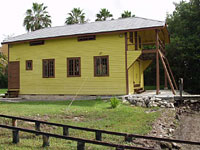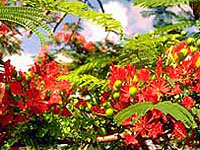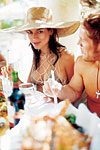|
ENTER COCONUT GROVE
CONDOS HOME PAGE
ENTER
COCONUT GROVE CONDO DIRECTORY
Brief History of
Coconut Grove
The earliest settlers of Coconut Grove were the
Pent and Frow families. In the 1830's both families were lighthouse
keepers at Cape Florida and homesteaders in what is now Coconut
Grove.
Another settler of that era was Edmund D. Beasley who homesteaded
160 acres bay front property. In 1873, after Beasley's death, his
widow rented their home to Dr. Horace P. Porter. He lived there for
only a year but during that time established a post office that he
named "Cocoanut Grove." When Porter left the area, the post office
was closed, but years later it was reopened using the same name.

Historic photo of the Peacock Inn
He persuaded his brother
Charles, then owner of a wholesale meat business in London, to join
him. Charles Peacock, his wife Isabella and their three sons
eventually settled in Coconut Grove and in 1882 opened the Bay View
House, later called the Peacock Inn, the first hotel in the area.
The Peacock Inn attracted all kinds of visitors including
scientists, authors, and nobility, many of whom remained to make
Coconut Grove their permanent home. Among the settlers were yacht
designer and wrecker Ralph Munroe whose home, The Barnacle, is now a
state historic site; homesteader Flora McFarlane, Coconut Grove's
first schoolteacher and founder of the Housekeeper's Club (now The
Woman's Club of Coconut Grove); and author Kirk Munroe.
The fledgling community grew and prospered, and by the early
years of the 20th century, a school, library, Sunday school, chapel,
and yacht club were built. Attracted by the climate, wealthy
Northerners, such as James and William Deering and William Jennings
Bryan made Coconut Grove their winter home. In 1925, the City of
Miami annexed Coconut Grove, but it continued to retain its own
identity.
As the population of South Florida
mushroomed, Coconut Grove Real Estate continues to grow.
Grove Art
Coconut Grove, with its verdant landscape, serene bay front
setting, and casual ambiance has always attracted artists. In the
1950's, artists from all over the US and as far away as Europe,
settled in Coconut Grove and established studios. The Grove soon
became known as an artists colony, and it was not unusual to see
artists setting up their easels on the sidewalks and painting the
local scene. By the 1960's there were many thriving art galleries as
well as Grove House, an artists' co-op. In 1963, the Coconut Grove
Arts Festival, now recognized as one of the leading arts festivals
in the country, was established. Rising real estate prices in the
1980's and 1990's caused most of the galleries to close, but the
artists have remained. In 1998, local artists formed The One Ear
Society, a group that holds juried exhibits in donated spaces.
While much of the "old Grove" has disappeared, it is still
possible to get a glimpse of what life was like in the past by
visiting Villa Vizcaya, The Barnacle, and The Kampong, three vastly
different Coconut Grove homes.

Villa Vizcaya as seen from the bay.
Villa Vizcaya, now a decorative arts museum set in the midst of
magnificent formal gardens, was originally the home of International
Harvester Vice President James Deering. Deering purchased the bay
front property in 1910 and hired architect F. Burrell Hoffman, Jr.
to design the house and an Italian Baroque farm village containing a
dairy, poultry house, barns, garage, and staff housing. This village
enabled Vizcaya to be entirely self-sufficient.
Deering traveled throughout Europe with interior designer Paul
Chalfin purchasing furniture and works of art for the house.
Construction began in 1914 and 1,000 craftsmen and artisans worked
on the house for two years. Deering moved in on Christmas Day, 1916,
arriving by yacht. All the furnishings Villa Vizcaya are just as
they were in Deering's time, including such early 20th centuries
amenities as a telephone switchboard, central vacuum cleaning
system, elevators and fire sprinklers. Deering enjoyed nine winters
at Villa Vizcaya before his death in 1925. Deering's descendants
sold Villa Vizcaya to Miami-Dade County in 1952, and in 1970 it was
placed on the Register of Historic Sites.

The Barnacle
Coconut Grove in its current state.
The Barnacle
Built in 1891 by Commodore Ralph Munroe, The Barnacle is the
oldest home in Miami-Dade County still on its original site.
Munroe, a native of New York City, moved to Coconut Grove in 1886
and made his living by designing yachts and working as a wrecker,
salvaging boats that had run aground in Biscayne Bay. A year after
he moved to the Grove, he founded the Biscayne Bay Yacht Club and
was its Commodore for more than 20 years.

The Kampong contains an array of flowering trees and
tropical fruit cultivars.
The Kampong
As Chief of the Seed and Introduction Section of the US
Department of Agriculture, Fairchild traveled all over the world
collecting plant specimens and bringing them back to his Coconut
Grove home. Scientists and world leaders such as Winston Churchill,
Richard Leakey, Henry Ford, Thomas Edison, and Dwight Eisenhower
have visited the Kampong. Another visitor was Fairchild's
father-in-law Alexander Graham Bell, who invented a device for
extracting fresh water from sea water while staying at The Kampong.
© 2000 Donna Sweeny
Coconut Grove Real Estate
Information
“The Grove” has been dubbed “the
village with a rhythm all its own.” A rhythm that is played out in
tree-lined streets, scores of shops, restaurants and night-spots and
a throbbing, upbeat street life that vibrates with a character all
its own.
Coconut Grove may have changed since its days as a bohemian
village populated by artists and radicals, but its zany charm and
energy are as potent as ever. Located on Biscayne Bay just ten
minutes south of Downtown Miami, The Grove is unlike any other
neighborhood in Greater Miami and the Beaches.

Coconut
Grove was originally a Bahamian fishing village later
settled by a few escapees from the frigid winters in the
North. Over the years, this heavily wooded area sitting
on a coral reef bluff some fifteen feet above sea level
became the winter home to many artists and wealthy
vacationers. Now Coconut Grove is one of the most
desirable areas in all of Miami. Coconut Grove has seen
its once small winter homes replaced by upscale single
family estates and luxurious condos on Bayshore Drive
across from Dinner Key marina.
Coconut
Grove residents can visit Cocowalk to find exciting
family entertainment, complete with restaurants, shops
and movie theaters. Tourists may want to stroll through
the historic Villa Vizcaya, or the Barnacle on Biscayne
Bay, which is one of the oldest homes in Miami. Art
lovers will want to explore the annual Coconut Grove
Arts Festival- one of the largest art festivals in the
nation. World class hotels, such as the Mayfair,
Ritz-Carlton and the Sonesta, draw vacationers and
visiting luminaries alike.
Coconut
Grove, located on Biscayne Bay just ten minutes south of
Downtown Miami, is unlike any other condo neighborhood
in Miami. Luxury waterfront and ocean view condominiums
flourish throughout this very secluded upscale mainly
single family home neighborhood. Popular Coconut Grove
condos include Grove Hill, Grove Isle,
Grovenor House, Mutiny Park and the Ritz Carlton.
Sightseeing
Coconut Grove’s waterfront parks offer the best vantage points
for observing manatees, wildlife and the sailboats in Biscayne Bay.
Dinner Key, originally the base for Pan American World Airways’
seaplane flights from Greater Miami in the 1930s, now houses
Miami City Hall
— which was converted from the original hangar. Earlier Grove
history is evident at
The Barnacle, the 110-year old home of pioneer Commodore Ralph
Munroe.
Festivals and street fairs such as the extraordinary Coconut
Grove Arts Festival; the Coconut Grove Food and Music Festival
(formerly Taste of the Grove); the Miami/Bahamas Goombay Festival
and the Banyan Arts Festival, add to Coconut Grove’s excitement.
Shopping
There's nothing dull about shopping in Coconut Grove: from
motor-bikes to fine jewelry, antique books to gourmet foods,
cutting-edge style to classic clothes — the specialty stores on the
downtown streets offer an exhilarating range of merchandise. In both
CocoWalk’s
open-air enclave and the Streets of Mayfair
strolling zone, shopping is part of the total dining and
entertainment experience. Look for stores featuring some of the best
known names in retailing, and individually owned shops that
epitomize sophistication and cool. And when the joys of shopping
fade, you can head for one of the bars or restaurants and round it
all off with a movie.

Dining and Night Life
Coconut Grove’s variety and originality is reflected in the
dining choices offered by its fine restaurants, themed eateries,
sports bars and casual outdoor cafes. On the menu find French,
Italian or Spanish-inspired cuisine; Mexican and American dishes and
seafood. In the Grove eating out is always in good taste.
Night life revolves around fun and funky neighborhood bars
livened up with jazz, salsa and reggae. Nocturnal pursuits focus on
the Grove’s favorite pastime of seeing and being seen. |






